As an Amazon Associate KitchenwareSets.com earns from qualifying purchases.
Vibrant Mexican Kitchen Decor Ideas for An Authentic Look
Do you ever look at your kitchen and feel like it’s missing something? Maybe it’s perfectly functional, a sea of neutral tones and stainless steel, but it lacks a certain warmth, a vibrant energy that makes you want to linger long after the meal is over. You yearn for a space that feels less like a sterile laboratory and more like the true, beating heart of your home—a place filled with color, character, and stories.
This desire for a kitchen with soul is a common one. Many modern designs prioritize minimalism at the expense of personality, leaving homeowners with a space that feels impersonal and uninspired. If you’re tired of the mundane and craving a room that celebrates life, culture, and the joy of gathering, you’ve come to the right place.
The perfect solution is Mexican kitchen decor, a style characterized by vibrant colors like deep reds and cobalt blues, rich textures, and handcrafted elements such as hand-painted Talavera tiles, rustic wood, and woven textiles. It’s a design philosophy that masterfully blends traditional charm with modern functionality to create a warm, inviting, and truly festive atmosphere. This guide will walk you through the essential elements to help you infuse your kitchen with this authentic, spirited look.
8 Core Elements for a Vibrant Mexican Kitchen (Updated for 2025)
To achieve an authentic and lively Mexican-inspired kitchen, you need to focus on a few key design principles. The beauty of this style lies in its artful combination of color, texture, and craftsmanship. By thoughtfully incorporating these core components, you can create a space that is both visually stunning and deeply personal, whether you lean towards a traditional hacienda feel or a more modern interpretation.
The core elements of Mexican kitchen decor include: 1. Colorful Talavera Tiles, 2. Rustic Wooden Elements, 3. Handcrafted Pottery, 4. Vibrant Textiles, 5. A Bold Color Palette, 6. Wrought Iron Accents, 7. Natural Greenery, and 8. Traditional Artwork. Let’s explore how you can bring each of these essential features into your home.
1. Embrace Colorful Tiles, Especially Talavera
The most iconic way to infuse your space with Mexican charm is by using colorful, hand-painted tiles, with Talavera being the most celebrated choice. These intricate ceramic tiles, known for their bold patterns and vibrant hues like cobalt blue and sunny yellow, instantly transform any surface into a work of art. They are most commonly used for backsplashes and countertops, adding a splash of festive energy that makes even daily cooking feel like a celebration.
Beyond the classic Talavera, large-format terracotta tiles are another staple, especially for flooring. Their earthy, warm tones provide a rustic foundation for the rest of the decor. When laid in a diagonal or herringbone pattern, they can even create an illusion of a more expansive space.
How to Install a Talavera Tile Backsplash:
- Materials Needed: Talavera or terracotta tiles, tile adhesive, grout, notched trowel, grout float, sponge, measuring tape.
- Step-by-Step Directions:
- Plan Your Design: Before you begin, lay out your tiles on the floor to create a pattern you love. I find that mixing and matching different Talavera patterns gives a wonderfully eclectic, traditional look, while using a single, repeating design can feel more modern and streamlined.
- Prepare the Surface: Ensure the wall or countertop is perfectly clean, dry, and level. A good foundation is key to a professional-looking finish.
- Apply Adhesive: Use your notched trowel to spread a thin, even layer of tile adhesive onto a small, manageable section of the wall.
- Set the Tiles: Gently press each tile into the adhesive with a slight twisting motion. Use tile spacers between each one to maintain consistent, even grout lines.
- Grout the Tiles: Wait for the adhesive to cure completely, which usually takes about 24 hours. Then, apply your grout with a grout float, making sure to press it firmly into all the gaps.
- Clean Up: Use a damp sponge to carefully wipe away any excess grout from the tile surfaces. Let the grout cure according to the manufacturer’s instructions, and your stunning new backsplash is complete!
Pro-Tip: From my own experience, if you’re working with a tight budget but still want that high-impact look, create a stunning focal point behind your stove using authentic Talavera tiles. You can then use simpler, less expensive subway or solid-color tiles for the rest of the backsplash. It’s a fantastic way to get that artisan feel without the high cost.
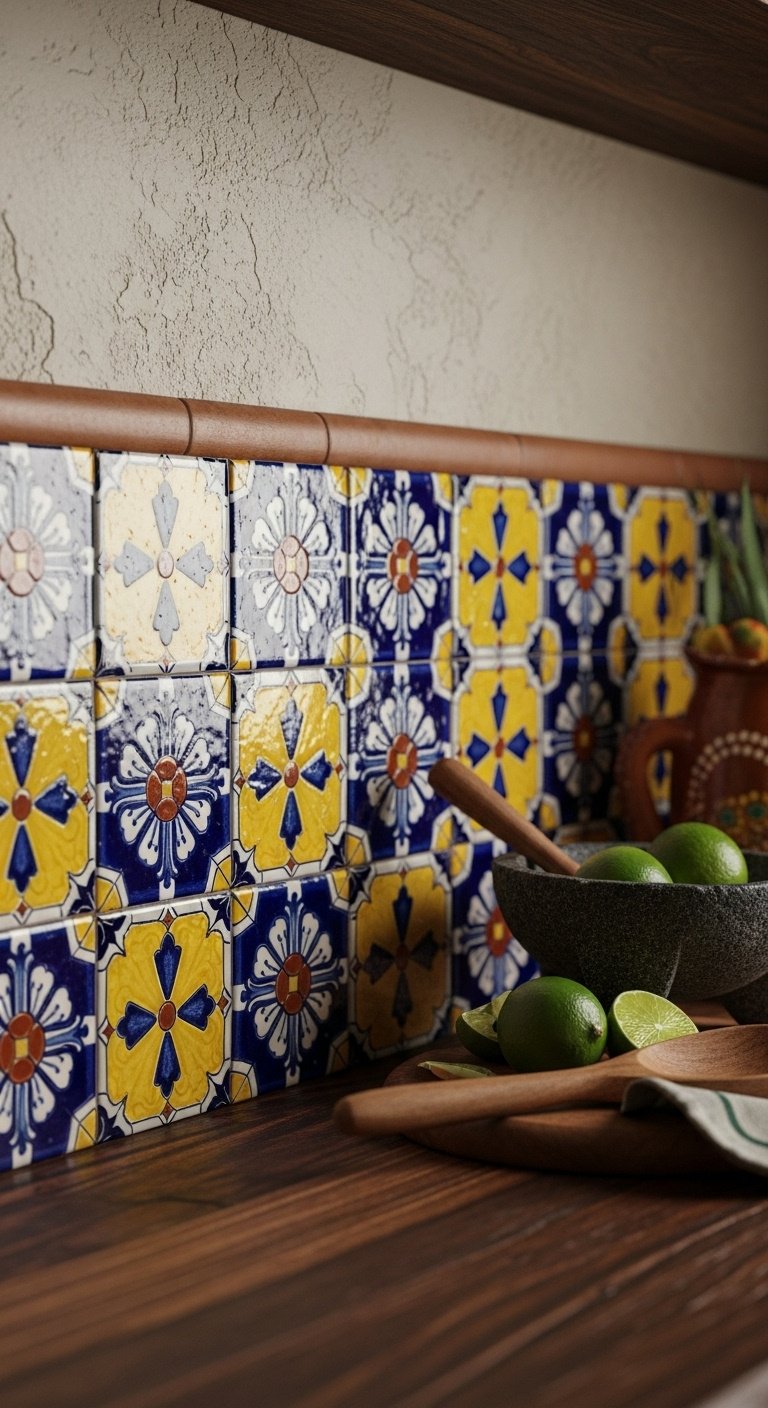
Pin this authentic tile idea for your kitchen remodel!
2. Incorporate Rustic Wooden Elements
To achieve that cozy, lived-in atmosphere, incorporating rustic wooden elements like cabinets, open shelving, and exposed beams is essential. The warmth and texture of wood, especially with a distressed finish, provides a beautiful contrast to the glossy, vibrant tiles. This natural material grounds the space and evokes the charm of a traditional Mexican hacienda.
Open shelving made of thick, reclaimed wood is a particularly popular feature. It not only adds rustic character but also provides a functional and visually appealing way to display colorful dishware, pottery, and other kitchen essentials. If your home’s architecture allows, exposed wooden beams can serve as a dramatic focal point, adding texture and the illusion of height to the room.
@everyday_homedecor KITCHEN REVEAL IS HERE! I hope it was worth the wait! 🎉Making decisions for a kitchen renovation can feel so overwhelming but it’s so exciting to see it all come together! I wanted to honor the style of the house and my own personal style to create the perfect Spanish / Mexican Modern Kitchen! I will list some of the sources here but I’ll link anything that’s available in my bio (LTK). Backsplash: Tabarka Studio “Med 26” Cabinet color: @Benjamin Moore “Pashmina” Lights: spanishrevivallighting.com Ceramics: @Artesanias Patricia Gaytan Oax Stools: Etsy- linked in bio (shoutout to @Home Decor Creator for sharing them!) #señoralife #homedecor #modernmexican #mexicanmodernism #mexicandecor #mexicankitchen #spanishstylehome
How to Install Rustic Open Shelving:
- Materials Needed: Reclaimed wood planks, heavy-duty shelf brackets (wrought iron style), stud finder, drill, level, measuring tape, wood stain or wax (optional).
- Step-by-Step Directions:
- Source Your Wood: For the most authentic feel, look for reclaimed or distressed wood planks. I’ve had great luck at local lumberyards and even salvage shops. The imperfections are what give it character!
- Locate Studs: This is the most critical step for safety. Use a stud finder to locate the wall studs where you plan to hang your shelves. You must anchor heavy shelves into the studs.
- Mark Your Placement: Use your measuring tape and a level to mark precisely where your brackets will go. Ensure they are perfectly level and aligned with each other.
- Install Brackets: Securely drill the wrought iron brackets directly into the wall studs.
- Prepare the Shelves: Cut your wood planks to the desired length. I like to give them a light sanding to smooth any splinters and then apply a protective wax to enhance the natural grain.
- Mount the Shelves: Place the finished wood planks on top of the brackets. If your brackets have screw holes, secure the shelves from underneath for extra stability.
Lesson Learned: Trust me on this one: always measure twice and drill once. I learned the hard way that ensuring your brackets are perfectly level is the absolute key to professional-looking open shelving that’s also safe enough to hold your treasured pottery.
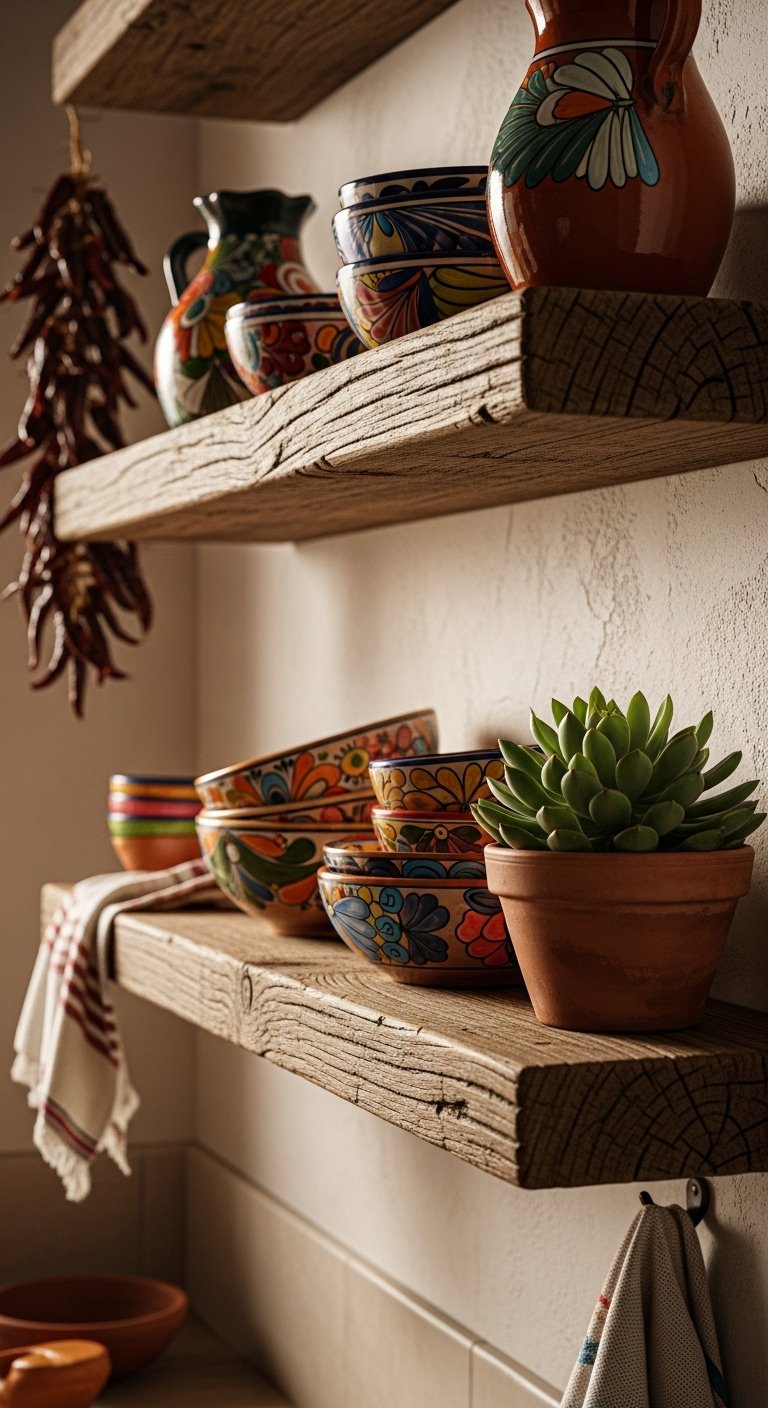
Save this rustic shelf idea to your ‘Dream Kitchen’ board!
3. Display Handcrafted Pottery & Accessories
The soul of a Mexican kitchen lies in its details, and the best way to elevate the aesthetic is by adorning the space with a variety of handcrafted items. This includes everything from colorful pottery and ceramic pieces to traditional kitchen utensils that are as beautiful as they are functional. Displaying items like clay pots, molcajetes (mortar and pestles), and cazuelas (earthenware pots) brings a tangible sense of traditional craftsmanship into your home.
Don’t forget to add texture with natural fibers. Handwoven baskets made from palm or agave are perfect for storing everything from fresh produce to kitchen linens, adding another layer of visual interest and rustic charm.
A Simple Styling Guide for Your Accessories:
- Step-by-Step Directions:
- Create a Focal Point: On an open shelf or a sideboard, group a collection of three to five earthenware pots (cazuelas) of varying sizes. This simple arrangement creates an instant, artful display.
- Combine Function and Beauty: I always keep my traditional molcajete right on the countertop. It’s a gorgeous sculptural object on its own, and it’s always ready for me to whip up some fresh guacamole or salsa.
- Use Vertical Space: A blank wall is a perfect canvas. Hang a collection of colorful, hand-painted decorative plates to create a vibrant gallery display that adds personality without taking up counter space.
- Add Texture with Baskets: Use oversized woven baskets for practical storage with a stylish twist. I keep one in a corner for my clean kitchen towels and a smaller one on the counter for onions, garlic, and avocados.
Pro-Tip: Before you use a new molcajete or an unglazed clay pot for the first time, it’s crucial that it be “cured.” I learned this from my grandmother. You’ll need to research the proper curing process, which usually involves grinding dry rice and spices, to prepare it for food use and ensure it lasts for generations.
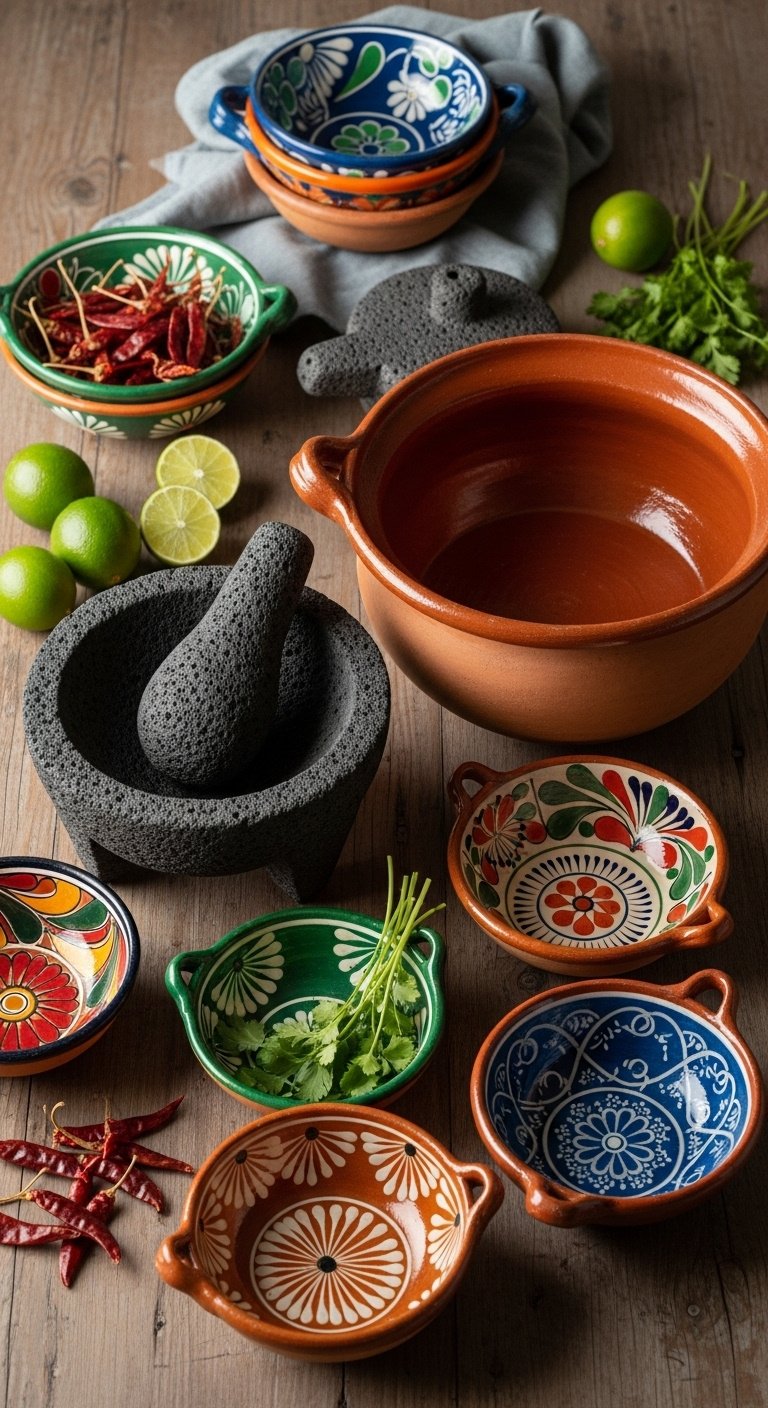
Want authentic decor? Pin this pottery inspiration!
4. Add Warmth with Vibrant Textiles
One of the easiest and most effective ways to create a welcoming environment is to add warmth and color through vibrant textiles. Incorporating table runners, woven placemats, dish towels, or curtains that feature traditional Mexican patterns and bold hues is a game-changer. These soft elements balance the hard surfaces of tile and wood, making the space feel instantly more inviting and festive.
Look for pieces with traditional woven patterns or Mexican embroidery. Even small touches, like a beautifully embroidered napkin or a colorful dish towel, can make a significant impact on the overall feel of your kitchen.
A Simple Textile Layering Technique:
- Step-by-Step Directions:
- Start with a Foundation: Drape a brightly colored, traditionally patterned table runner down the center of your kitchen table or island. This immediately sets a festive tone.
- Layer with Placemats: On top of the runner, add handwoven placemats. I like to use a complementary color or a more neutral, natural fiber like jute to create depth and texture.
- Incorporate Functional Textiles: This is my favorite simple trick: hang a vibrant dish towel with beautiful Mexican embroidery from your oven handle or a nearby hook. It’s a small detail that adds a huge pop of color and charm.
- Soften the Windows: If you have a kitchen window, consider a simple valance or a pair of cafe curtains in a fabric featuring bold red, yellow, or blue hues. It frames the view and adds another layer of softness.
Pro-Tip: Don’t be afraid to mix and match patterns! The key I’ve found is to keep them within a similar color family. For example, a striped runner can work beautifully with floral embroidered napkins if they both share a dominant color, like a rich cobalt blue.
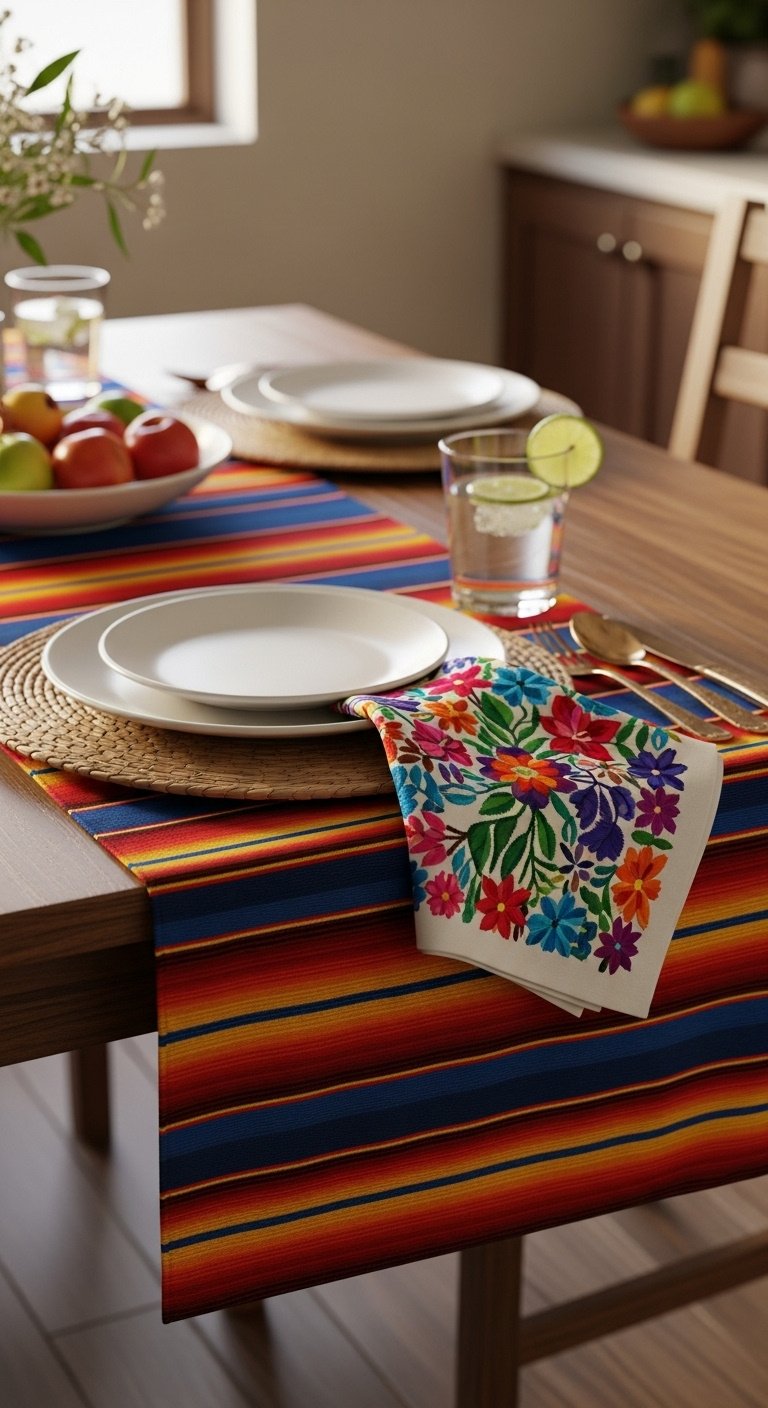
Add a pop of color! Pin these textile ideas.
5. Paint with a Bold Color Palette
To capture the vibrant character of Mexican culture, you must embrace a bold and energetic color palette. This style moves beyond safe neutrals and celebrates life with bright shades like fiery red, deep yellow, turquoise, and cobalt blue. These colors can be used on walls, cabinets, furniture, or accessories to infuse the kitchen with an undeniable energy.
At the same time, earthy tones are just as important. Warm colors like terracotta and adobe provide a beautiful, grounding base that prevents the brighter hues from becoming overwhelming and contributes to the overall warm ambiance.
A Practical Guide to Applying Color:
- Step-by-Step Directions:
- Choose a Foundation: I recommend starting with a warm, earthy tone like terracotta or a soft adobe for the main walls. This creates a cozy, inviting base and makes any other colors you add truly pop.
- Create an Accent Wall: If painting the entire kitchen feels too daunting, choose just one wall to make a statement. The wall behind a breakfast nook or a small, feature wall is perfect for a vibrant shade like deep sunny yellow or a rich turquoise.
- Paint Your Cabinets: For a major transformation, painting your cabinets is the way to go. I’ve seen stunning kitchens with daring cobalt blue lower cabinets or a kitchen island painted a fiery red. To keep it balanced, you can leave the upper cabinets or walls a more neutral color.
- Add Small Pops of Color: If you can’t make permanent changes, introduce color through accessories. Paint your bar stools a cheerful yellow, find a turquoise trash can, or proudly display a fiery red stand mixer on your counter.
Lesson Learned: This is a big one: always, always test paint samples on your wall first. I once fell in love with a terracotta color in the can, but on my wall, it looked completely different. The color can change dramatically depending on your kitchen’s natural and artificial lighting throughout the day.
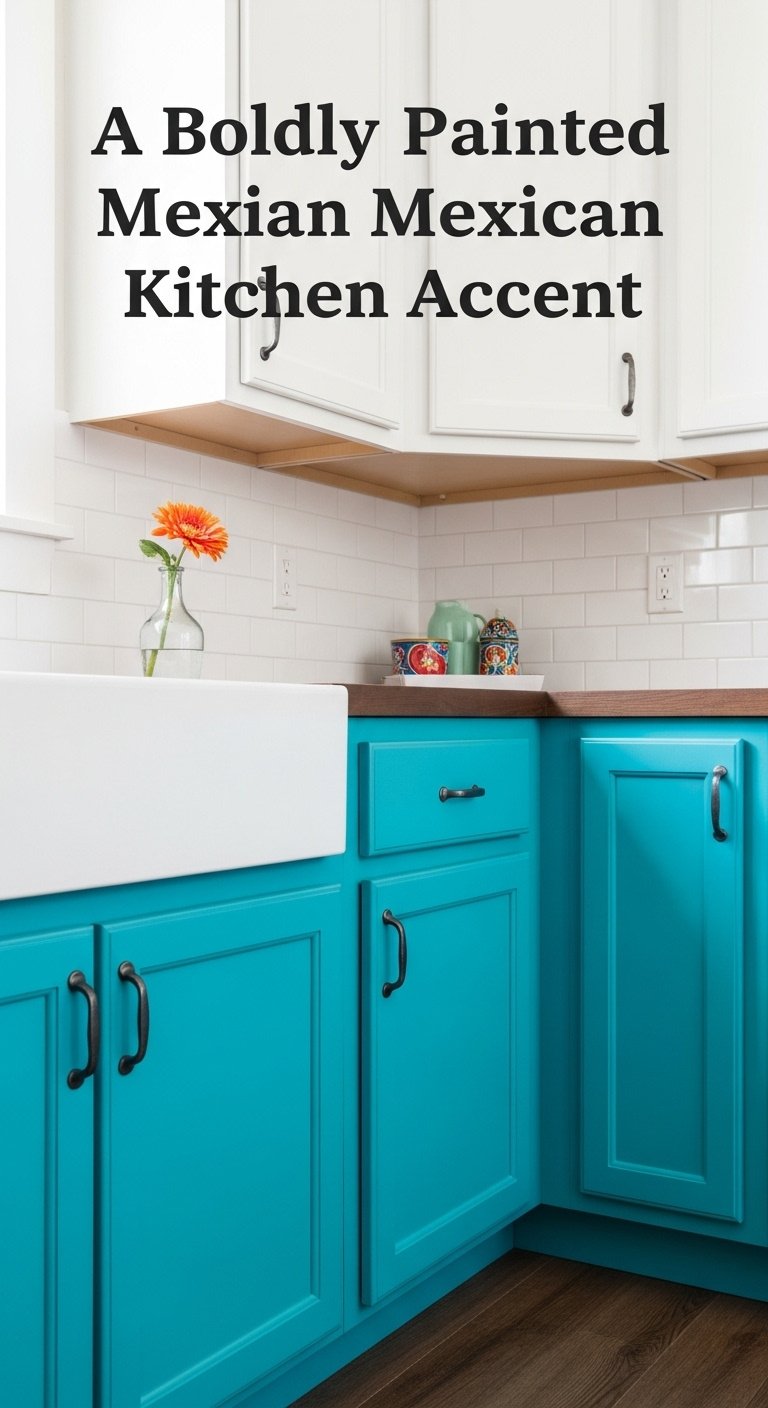
Feeling bold? Save this color idea for your next project!
6. Integrate Wrought Iron & Metal Accents
To add an authentic, rustic, and structural touch, incorporate accents made of wrought iron and other complementary metals like copper. These materials have a long history in Mexican design and add a sense of handcrafted elegance. Wrought iron is commonly seen in light fixtures, cabinet handles, pot racks, and decorative wall pieces.
A gleaming copper range hood can serve as a stunning centerpiece, especially when contrasted against earthy walls or dark, rustic cabinetry. These metal elements provide a beautiful textural contrast to the wood and tile, adding another layer of depth and authenticity to the design.
A Simple Guide to Adding Metal Accents:
- Step-by-Step Directions:
- Upgrade Cabinet Hardware: The easiest and most affordable way to start is by swapping out standard, generic cabinet knobs and pulls for rustic, heavy wrought iron hardware. This small change makes a surprisingly big difference.
- Make a Statement with Lighting: Replace a boring ceiling fixture with an elegant wrought iron chandelier over your dining table. Alternatively, a series of pendant lights with colorful blown-glass shades over the island can add both light and artistry.
- Invest in a Focal Point: If your budget allows, nothing makes a statement quite like a gleaming copper range hood. It becomes the undeniable centerpiece of the entire kitchen and looks spectacular.
- Accessorize with Iron: Look for smaller decorative wrought iron pieces to scatter throughout the space. A wall-mounted pot rack, a decorative trivet for the counter, or even a simple wrought iron fruit bowl can add that perfect finishing touch.
Pro-Tip: To maintain a cohesive and polished look, I always advise clients to stick to one primary metal (like wrought iron) and one accent metal (like copper). This prevents the space from looking visually cluttered and ensures that your beautiful statement piece, like that copper hood, truly stands out.
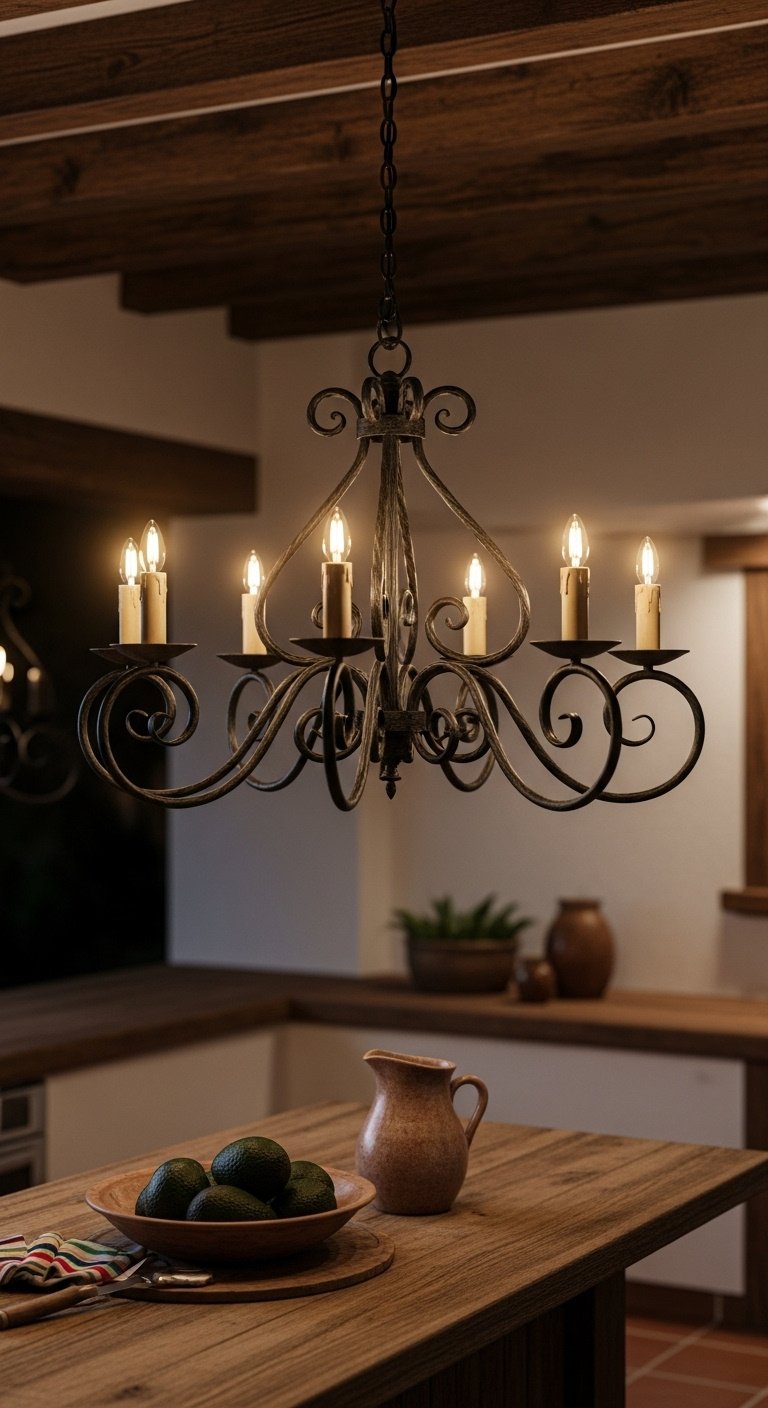
Pin this elegant lighting idea for a touch of hacienda charm!
7. Bring in Natural Elements & Greenery
To breathe life and natural beauty into the space, you should incorporate plenty of plants, especially cacti and succulents. These plants are not only fitting for the aesthetic but are also famously low-maintenance. Using classic terracotta pots for your herbs and small plants further enhances the authentic, earthy feel of the kitchen.
Greenery provides a wonderful, organic contrast to the hard materials in the room. It softens the edges, purifies the air, and adds a touch of serene, natural beauty that makes the kitchen feel fresh and alive.
A Simple Plant Styling Guide:
- Step-by-Step Directions:
- Cluster Succulents: Create a charming little collection of various succulents and cacti. I love potting them in different sizes of classic terracotta pots and arranging them on a sunny windowsill or a floating shelf.
- Start an Herb Garden: What could be better than fresh herbs at your fingertips? Plant essentials for Mexican cooking—like cilantro, oregano, and mint—in individual terracotta pots. Keeping them on the counter near a window is both beautiful and incredibly practical.
- Go Big with a Statement Plant: If you have the floor space, a single tall cactus can act as a living sculpture. It becomes a dramatic and unexpected focal point.
- Hang Your Plants: To add vertical interest, use macrame hangers to suspend trailing plants like a string of pearls or a burro’s tail succulent in a corner of the room.
Lesson Learned: I’ve killed my fair share of plants, but the biggest lesson I’ve learned about cacti and succulents is that they thrive on neglect. The most common mistake is overwatering. Make sure their pots have excellent drainage holes and let the soil dry out completely between waterings.
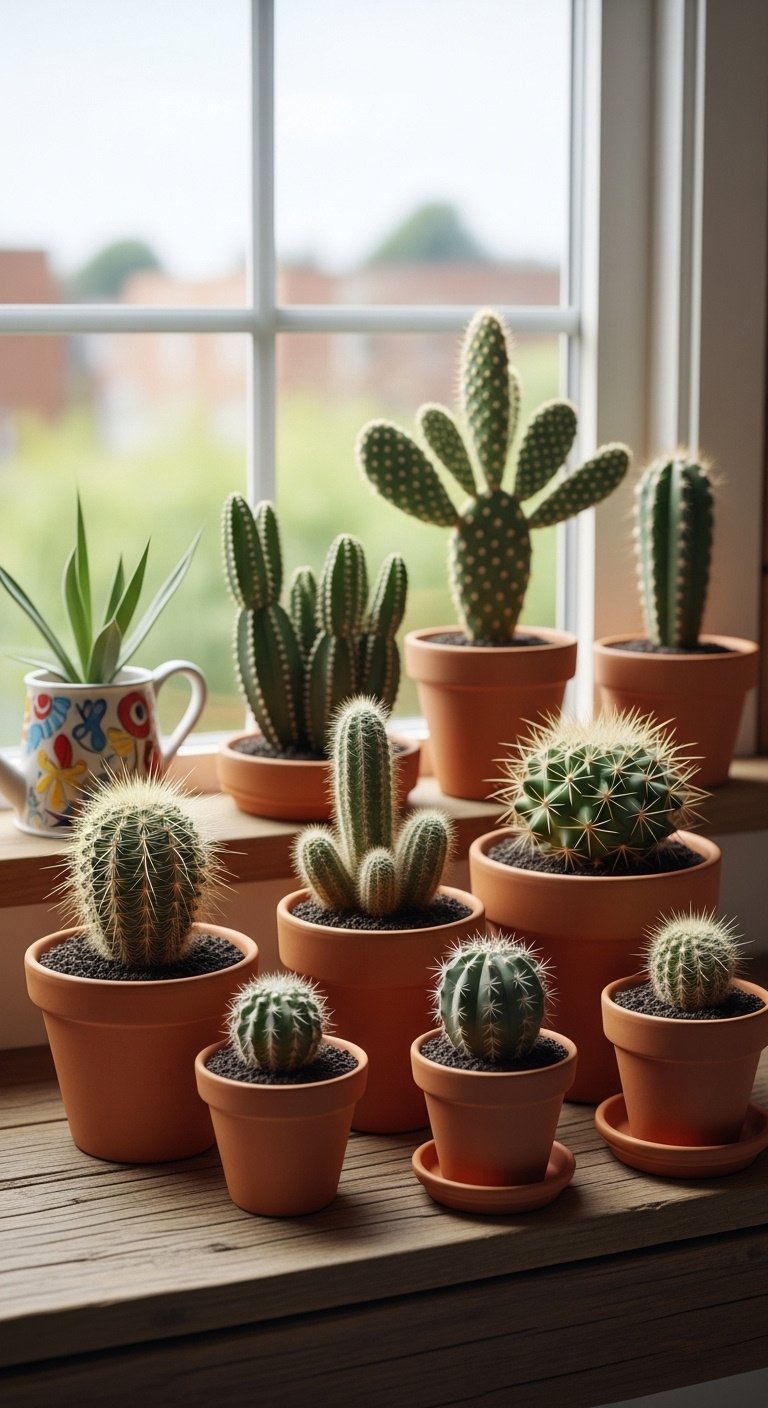
Add some life to your kitchen! Pin this greenery idea.
8. Finish with Artwork & Personal Touches
The final, crucial element is to infuse the kitchen with character by adding traditional artwork and personal touches. This is what transforms a beautifully decorated room into a home. Adorning your walls with traditional Mexican artwork, such as hand-painted ceramics, folk art, or prints inspired by Mexican culture, adds a layer of soul and story.
Don’t forget to make the space your own. Displaying family photos in colorful, rustic frames or adding a chalkboard wall for notes, recipes, and doodles can personalize the kitchen and make it a true reflection of your family.
A Simple Guide to Personalizing Your Space:
- Step-by-Step Directions:
- Source Authentic Art: Look for Mexican folk art to create a unique gallery wall. I love using items like tin nichos, small Day of the Dead figures, or colorful prints by Mexican artists.
- Display Hand-Painted Ceramics: A large, intricately painted ceramic platter can be a stunning statement art piece when hung on the wall. A group of smaller ones works just as well.
- Frame Your Memories: Don’t hide your family photos away. Display them proudly on a shelf or wall in brightly colored, rustic wooden frames that complement your decor.
- Create a Functional Feature: One of my favorite projects is painting a small wall or even a cabinet door with chalkboard paint. It’s perfect for jotting down grocery lists, planning the weekly menu, or leaving sweet notes for the family.
Pro-Tip: The most authentic and beautiful spaces are those that feel collected over time. My best advice is not to rush to fill every single wall. Start with one or two meaningful pieces of art and slowly add to your collection as you find things you love. This creates a space that truly tells your unique story.
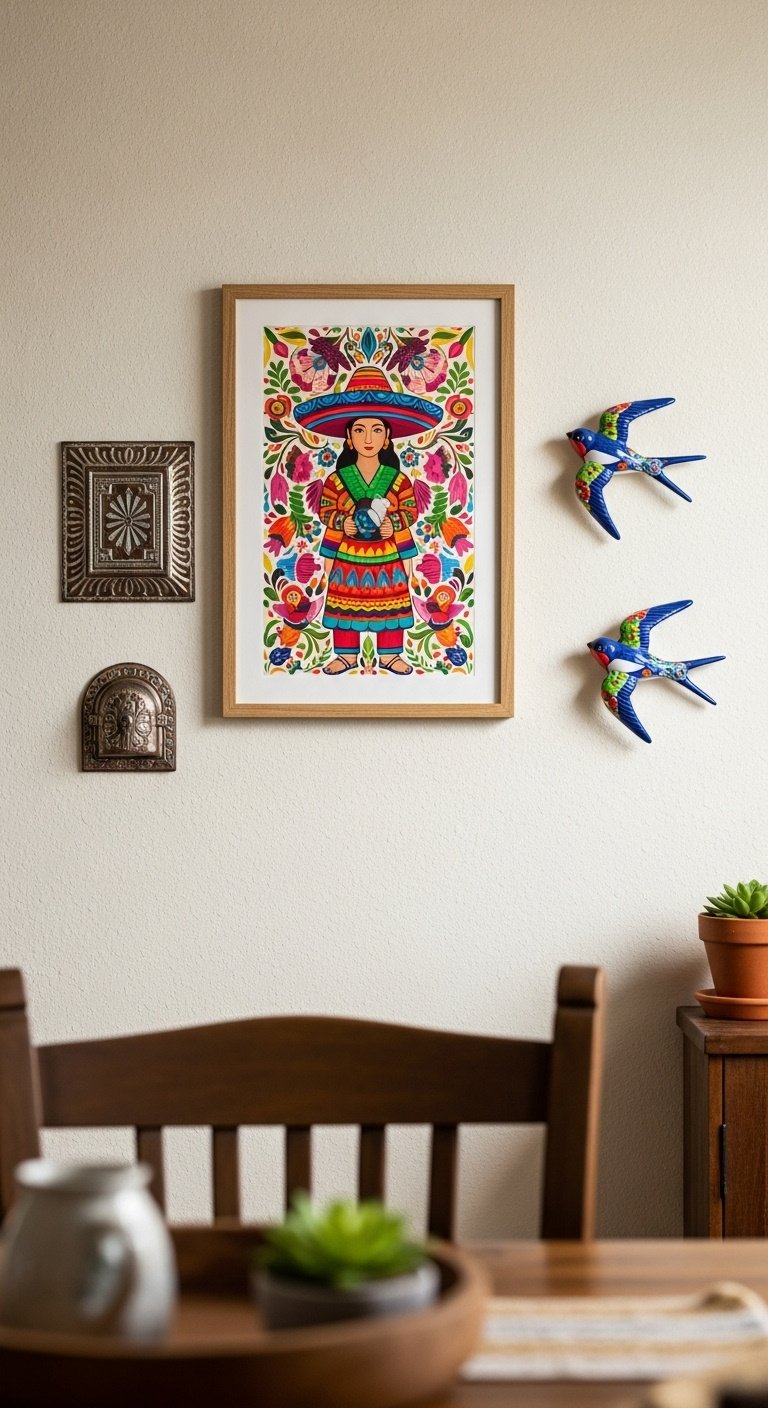
Make it personal! Pin this folk art idea for your walls.
Key Takeaways: Your Quick Guide to Mexican Kitchen Decor
Feeling inspired? Here’s a quick summary of the most important strategies for achieving that authentic, vibrant Mexican kitchen look you’re dreaming of. Keep these points in mind as you start your design journey.
- Vibrant Color is Key: Don’t be shy with color. Use a base of earthy tones like terracotta and accent with bold hues like cobalt blue, turquoise, and sunny yellow on walls, cabinets, or tiles.
- Embrace Handcrafted Items: The soul of the style is in its craftsmanship. Prioritize authentic pieces like hand-painted Talavera tiles, woven textiles, and traditional pottery (molcajetes, cazuelas).
- Texture is Everything: Layer different textures to create warmth and depth. Combine rustic, distressed wood with smooth, glossy tiles, heavy wrought iron, and soft, woven fabrics.
- Start Small: You don’t have to do a full remodel. You can begin by adding vibrant textiles, displaying pottery on open shelves, or creating a small gallery wall with Mexican folk art.
People Also Ask About Mexican Kitchen Decor
What is Mexican decor called?
Mexican decor is often referred to as Hacienda style, Spanish Colonial style, or simply Mexican style. It is characterized by its use of vibrant colors, rustic materials like wood and wrought iron, handcrafted items such as Talavera tiles and textiles, and a warm, inviting atmosphere that reflects Mexico’s rich cultural heritage.
What are the colors of Mexican kitchens?
Mexican kitchens are celebrated for their bold and vivid color palettes. Common colors include warm earthy tones like terracotta and adobe, paired with vibrant hues like fiery red, sunny yellow, cobalt blue, and turquoise. These colors are used on walls, tiles, cabinetry, and decorative accessories to create a lively and festive space.
What are the elements of Mexican decor?
Key elements of Mexican decor include hand-painted Talavera ceramic tiles, rustic hand-carved wooden furniture and beams, and wrought iron light fixtures and hardware. Vibrant handwoven textiles for things like table runners and placemats, handcrafted pottery, cacti and succulents in terracotta pots, and traditional folk art are also essential components.
Final Thoughts
Creating a kitchen with vibrant Mexican decor is so much more than a design choice; it’s about crafting a space that feels alive, welcoming, and full of stories. By layering these rich colors, textures, and handcrafted elements, you can transform your kitchen from a purely functional room into the true, beating heart of your home—a place where memories are made and life is celebrated.
Which of these ideas are you most excited to try first? Let me know in the comments below
